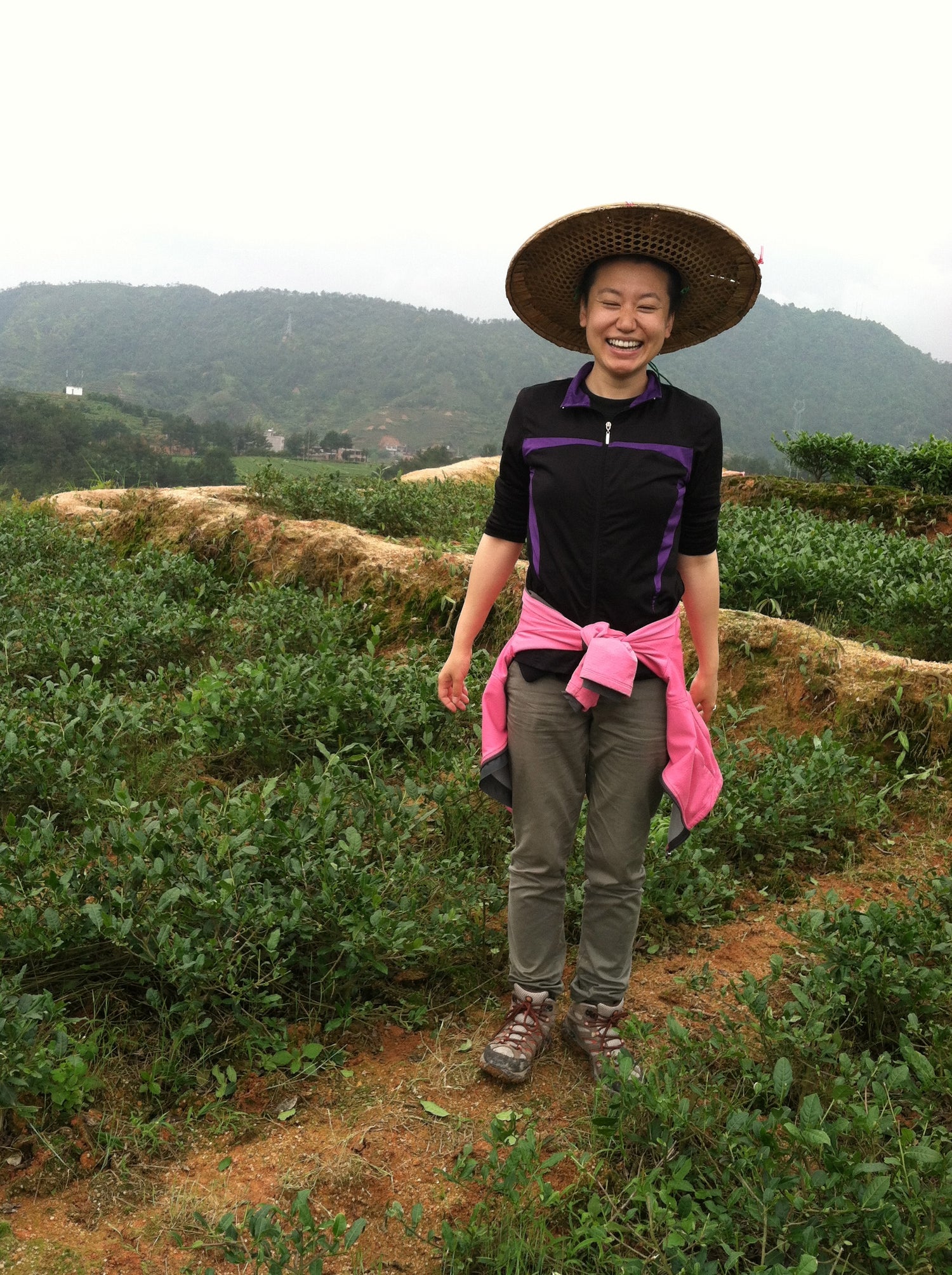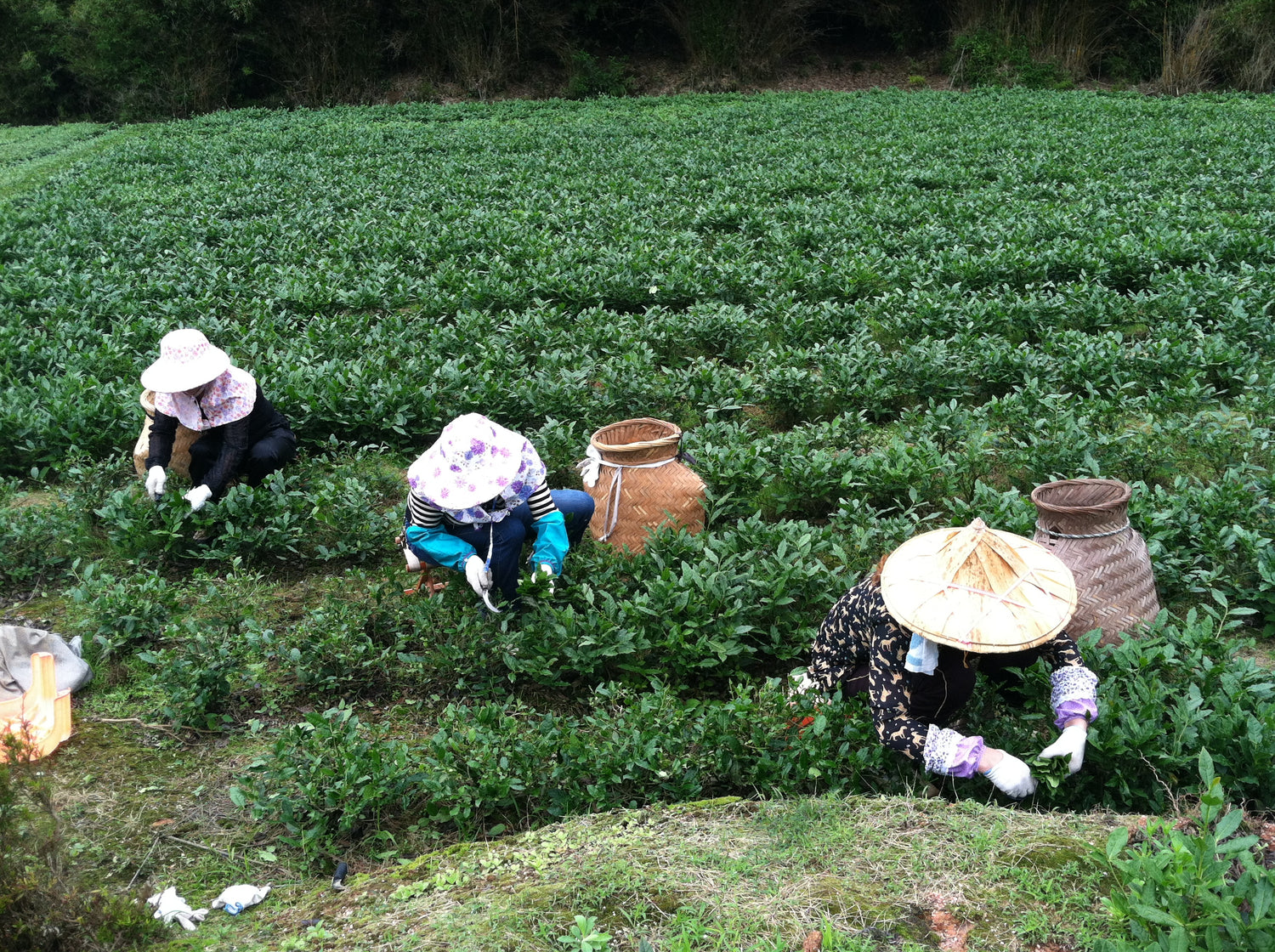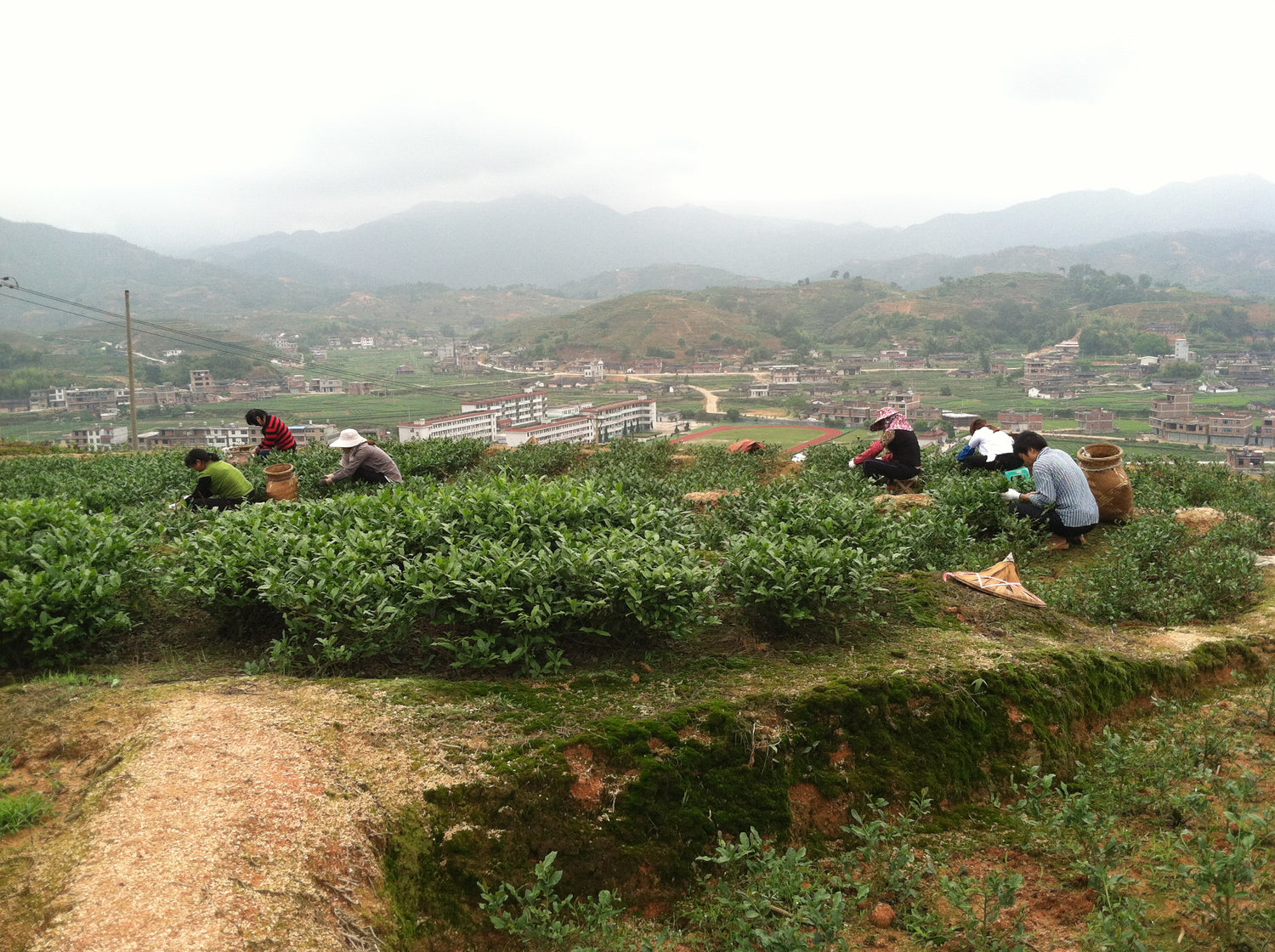History of Tie Guan Yin
Tie Guan Yin style of Wu Long (Oolong) is believed to have originated in the early 1700s. Like all China's top teas, endorsements from influential historical figures are essential to a tea's rise to fame. In the case of Tie Guan Yin, its chief patron is rumored to be Emperor Qian Long.
According to legend, Emperor Qian Long (1711 – 1799) was impressed with the tea's "weight of iron and appearance of Guan Yin," hence the name Tie Guan Yin, Iron Guan Yin. Guan Yin (or Gua Shi Yin) is the Chinese word for Avalokitasvara Bodhisattva. The farmers, however, have long been describing the shape of Tie Guan Yin as "dragonfly head and toad tail." What a difference! The academic name for Tie Guan Yin's shape is half-ball, or Ban Qiu Xing 半球形. Tie Guan Yin is often mistranslated to Iron Goddess of Mercy. This common mistake is probably due to the feminine depiction of Guan Yin in a lot of Chinese folk arts and Guan Yin's promised work of compassion for all. However, Guan Yin, in their enlightened form, is genderless. When Guan Yin reincarnated to mortal form, he was a man in Buddhism legends. This mistranslation has caused difficulty recognizing the same tea between Chinese and Western consumers.

Geography
Because Tie Guan Yin has been a renowned tea for some time, a sizable tea region is dedicated to its production. The true historical origin of Tie Guan Yin is An Xi County 安溪縣 – and like all China's true origin loose leaf teas, the teas that come from this region are referred to as An Xi Tie Guan Yin. You can read more about naming conventions here. Within An Xi, the producing area is divided into the inner mountains 內山 and outer mountains 外山. The inner mountain towns are the core terroir, demanding higher prices for the tea produced.
Inner Mountain Towns: Gan De感德, Chang Keng長坑, Xiang Hua祥華, Jian Dou劍斗Outer Mountain Towns: Xi Ping西坪, Long Juan龍涓, Da Ping大坪, Jin Gu金谷, Hu Tou湖頭
Xi Ping Township, the Origin of Tie Guan Yin
The Tie Guan Yin style was first developed in the township of Xi Ping 西坪, but today, this township sits in the outer mountain region. The most renowned location for Tie Guan Yin is the village of Huai Zhi 槐植 of Gan De Township 感德鎮. But, ever since a highway was constructed through the town, the quality of the loose leaf tea has raised many questions, though it still commands the highest price in the market.
As expansive as the county of An Xi is, a majority of Tie Guan Yin on the market are not even from An Xi but mass-produced in nearby regions like Zhang Zhou 漳州, where there are miles and miles of tea plantations.
Tie Guan Yin Varietals
Sub-Categories of Tie Guan Yin
There are two subcategories of Tie Guan Yin.
Chuan Tong 傳統 (Traditional)
Qing Xiang 清香 (Light)
The classification can be confusing, so here's an overview:
Though many associate roasting with Traditional Tie Guan Yin, the fermentation method/level is what determines a Traditional Tie Guan Yin.
Traditionally, Tie Guan Yin is fermented at room temperature, which is still common practice in other Wu Long (Oolong) regions. However, in the late 1990s, an "innovative" method of making Wu Long (Oolong) with less shaking and controlled temperatures was introduced to An Xi from Taiwan. This change results in a tea with a tall aroma, though compromised texture and clarity.
The distinction between traditional and light Tie Guan Yin is whether a tea is fermented at natural temperature with more shaking, resulting in heavier fermentation, or controlled temperature with less shaking, resulting in lighter fermentation. The tea trend focused on aroma also expanded to other tea regions, though with more resistance. The now very famous Ya Shi Xiang (Duck Sh*t) of Feng Huang Wu Long (Dan Cong) is considered a Qing Xiang version of Dan Cong.
How Feng Huang Dan Cong is Made and Processed
-
1. Picking
Like all Wu Longs, Tie Guan Yin uses only leaves, not buds. The picking standard for Tie Guan Yin is Zhong to Da Kai Mian 中到大開面, medium to large "opening," which are the more mature leaves. Usually, three or four leaves are picked together with the stems.
-
2. Wilting
The leaves are then sun wilted until soft and moved inside to continue wilting. The wilted leaves are shaken 3 to 5 times with 1.5 to 2 hours between rounds.
-
3. Shaking
Shaking loose leaf tea is the most essential and skilled part of making Wu Long (Oolong). This step is highly intuition-based knowledge gained only through experience. Though mass-produced teas are usually timed, handmade Wu Long requires a maker to stay up all night to monitor the "water travel" status continuously. This concept refers to the degree of water fed from stems then evaporated from the leaves to determine the next "hand" – the following technique. Ideally, a well-fermented leaf should look yellowish-green in the center and dark red around the edge.
-
4. Fermenting/Wok Frying
Once the final shaking completes (this usually takes place throughout the night), the leaves are left to continue fermenting to the desired level and then wok (or tumble) fried in the morning to destroy the enzymes. The enzymes stop the fermentation and seize the tea at an optimal level of aroma and texture.
-
5. Rolling and Baking
The hot-out-of-the-wok tea is then rolled rigorously into the signature half-ball shape. The modern-day making of Tie Guan Yin also sometimes involves a step before the rolling, where a maker beats the tea to get rid of the red edges, resulting in a less bitter tea with a more transparent liquid. The rolled tea is then baked dry, giving us Tie Guan Yin mao cha 傳統鐵觀音毛茶, or rough tea. When Traditional Tie Guan Yin rough tea is un-roasted, it has a green color with a bright and flowery profile, but it should not be mistaken for a Light Tie Guan Yin.
-
6. Roasting and Finishing
Once a rough tea is medium roasted (usually twice) and the stems removed, it is a finished Traditional Tie Guan Yin. Roasted Tie Guan Yin has a metallic toasted rice taste and golden liquor. The fining process is very tedious and time-consuming. But, it is also a shared characteristic of all the historically famous teas where each painstaking step pushes the tea to be a fraction better. Wu Long (Oolong) stem picking usually takes months to finish. There are plenty of Wu Long (Oolong) still sold with stems in the market. Stems don't taste bad; they are mildly sweet. But, they dilute the complexity of a tea because it occupies volume (and weight) and is overall not a sign of fine loose leaf tea.
Making Light Tie Guan Yin
A Light Tie Guan Yin has a lower fermentation level and slightly different processing. It is usually fermented at a controlled temperature with less tea shaking. Depending on when the tea's enzymes are destroyed to stop the metabolism, there are five types of Light Tie Guan Yin.
It is important to note that a Light Tie Guan Yin can also be roasted, and the finished tea is called Nong Xiang Xing Tie Guan Yin 濃香型, or heavy Tie Guan Yin. This finished tea is not to be mistaken with the actual Traditional Tie Guan Yin. Zheng Chao 正炒 Tie Guan Yin is the oldest and the most similar to traditional Tie Guan Yin, with the main difference being the fermentation temperature. Other new styles all involve shaking the tea less frequently or not at all. The later the kill green step, the less shaken the tea. As the tea holds its water for longer (no shaking and delayed kill green), it creates a sour taste in the tea that some drinkers prefer. The most delayed style, Tuo Suan 拖酸, literarily means delay-to-sour. The new techniques are very controversial with strongly opinionated fans and critics. There's also a general correlation between style and location. For example, Gan De and Xiang Hua are more known for the new styles, while Chang Keng and Xi Ping are more known for the traditional and Zheng Chao.
The 2012 Scandal
In 2012, Greenpeace China sampled a selection of name-brand teas (including Ten Ren and Lipton). It reported that most of them have pesticide residues, with Tie Guan Yin as the prime example. This report, and many incomplete versions of it, made Tie Guan Yin the "poison tea" overnight and pushed topics such as pesticide and fertilizer usage, monoculture, and cloning to heated discussions.
While most farmers of historic teas never bothered to go through organic certification because it usually is not favored by long-time connoisseurs of traditional teas, Tie Guan Yin farmers were the exception. Since 2012, many Tie Guan Yin farmers could not sell their tea without at least a locally issued organic certification. By 2015, the general tea price dropped to 1/10 of before the scandal, leaving many tea fields unattended and tea workers displaced. In 2016, when tea safety became topical again, many scholars criticized the unscientific method used during the 2012 test and questioned its conclusion. Many also argued that the mass-produced teas sampled were not even from An Xi. Because of this event and the manifestation of Tie Guan Yin industrialization, traditional terroir division became less and less critical. Experienced tea buyers now instead seek out "uncontaminated" lots in the An Xi and work with farmers who make a less manufactured version of the tea.

The Harvest Season
Tie Guan Yin is the only tea with an autumn harvest that sells as well as the spring's, and on occasion, even more so. All other teas' autumn harvest trades 1/3 the amount of spring, with core regions not even harvesting in fall or winter. This unique harvest is due to the stormy weather during the spring season (early May) and Tie Guan Yin's emphasis on a clear aroma. There's a saying in Tie Guan Yin called spring water, autumn aroma 春水秋香– means that the spring tea wins in taste and mouthfeel (water) and autumn tea wins in aroma. There's also a custom among connoisseurs to drink spring tea in autumn and autumn's tea the following spring.
Qualities of High-Quality Tie Guan Yin
When drinking a heavily brewed Tie Guan Yin, you can feel a tightening sensation at the ends of your tongue along the cheeks where the umami receptors are, giving one a sour feeling but not a sour taste.
Many refer to this as the Guan Yin Yun.
Another reference to a high-quality Tie Guan Yin's exquisite clarity in the aroma is its airy, bright quality (can't be heavy or dull) that lingers forever (known as chime). Like other high-quality teas, the lingering throat sensation (sweetness) is called Hou Yun and is highly sought after.
Color is another telltale of a Tie Guan Yin's quality. A whiter or less colored liquor of rough tea is better when everything else is equal. Lower quality Tie Guan Yin usually has a deeper green color with perfume aroma and a powdered taste, or with heavy roast and dampness in the taste. A well-made Tie Guan Yin has sizable red edges or broken edges around a whole leaf.

